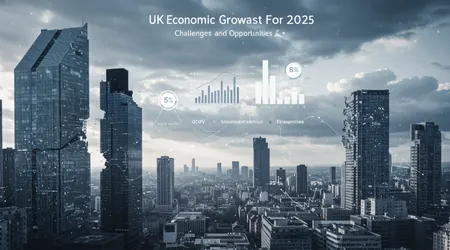UK Economic Growth Forecasts for 2025: Challenges and Opportunities

Economic growth projections for the UK in 2025 hover between 1.0% and 1.6%, painting a cautious yet dynamic picture.
The International Monetary Fund (IMF) recently slashed its forecast from 1.6% to 1.1%, citing global trade disruptions and domestic policy uncertainties.
Meanwhile, the EY Item Club predicts a more conservative 0.8%, reflecting concerns over persistent inflation and U.S. tariffs.
These figures underscore a pivotal moment for Britain, balancing recovery from post-pandemic scars with new global challenges.
But what does this mean for businesses, households, and policymakers?
This article dives into the headwinds and tailwinds shaping the UK’s financial future, offering practical insights and forward-thinking strategies.
From trade shocks to green innovation, we’ll explore how the nation can navigate this complex landscape.
The Global Trade Shock: Tariffs and Uncertainty
U.S. tariffs, announced on April 2, 2025, have spiked to a 90-year high of 14.5%, rattling global markets. The UK, heavily reliant on exports, faces a economic growth slowdown as trade costs rise.
The IMF notes these tariffs could shave 0.5% off UK GDP. Businesses like Sheffield’s steel exporters now grapple with higher costs, potentially passing them to consumers.
This isn’t just about numbers it’s about real-world impacts. Take Jane, a small-business owner in Manchester exporting ceramics. Her U.S. clients now face 10% higher costs, threatening her margins.
Can she absorb these costs or pivot to new markets?
Beyond tariffs, uncertainty stifles investment. The EY Item Club highlights businesses delaying expansions due to unpredictable trade policies.
++ Corporate Profit Shifting to Low-Tax Jurisdictions Under Parliamentary Scrutiny
Mid-sized firms, generating £130bn in overseas revenue last year, are particularly vulnerable.
Yet, there’s a silver lining. Chancellor Rachel Reeves is pushing for a U.S. trade deal to mitigate tariff impacts. If successful, this could stabilize export markets and boost confidence.
For now, businesses must adapt rerouting supply chains or exploring EU markets could be key.

Inflation and Interest Rates: A Delicate Balancing Act
Lingering inflation, projected to hit 3% by late 2025, threatens economic growth. The Bank of England (BoE) faces pressure to cut rates, with the IMF predicting three reductions this year.
Lower rates could ease borrowing costs for firms like London tech startups.
However, inflation complicates this. Rising energy bills and import costs, driven by tariffs, squeeze household budgets.
Also read: Select Committees Call for Stable Funding for BBC World Service
Consider Tom, a Birmingham teacher whose grocery bill has climbed 15% since 2024. His spending power shrinks, dampening retail demand.
The BoE’s February 2025 rate cut to 2.25% sparked debate. Some argue it fuels inflation; others see it as vital for growth.
The EY Item Club warns that persistent price pressures could delay recovery until 2027.
Still, opportunities exist. Lower rates could spur housing investment, with firms like Barratt Developments eyeing expansion.
Policymakers must tread carefully, balancing inflation control with growth incentives.
Read more: DoorDash Makes $3.59 Billion Bid for UK’s Deliveroo
Productivity and Innovation: The Engine of Recovery
Low productivity remains a drag on economic growth, with the UK lagging G7 peers.
The OECD reports UK output per worker grew just 0.2% in 2024. Post-pandemic recovery demands innovation, particularly in tech and green sectors.
Consider GreenWave, a Bristol startup developing solar-powered charging stations. Its success hinges on government grants and R&D tax breaks.
Such firms could drive long-term growth, but funding is tight. The 2025 budget, set for May, must prioritize innovation.
Automation offers another path. Santander UK’s push to streamline operations could save £200m in 2025, boosting efficiency. Yet, small businesses often lack capital for such upgrades.
Encouragingly, the UK’s tech sector is thriving. London’s fintech hub attracted $12bn in 2024, per Dealroom data.
Scaling this success requires infrastructure investment and skills training to close the productivity gap.
Digital transformation isn’t just for tech giants. A Leeds bakery adopting AI for inventory management cut waste by 20%, proving small-scale innovation matters.
Could your business follow suit?
Post-Pandemic Recovery: Uneven Progress
The UK’s GDP in Q4 2024 was 3.4% above pre-pandemic levels, per the House of Commons Library. Yet, economic growth is uneven.
Retail sales rose 0.4% in March 2025, but consumer confidence plummeted to -23, per GfK’s index.
Sectors like hospitality, still recovering from 2020 lockdowns, face new tariff-related cost hikes.
A Liverpool pub owner, Sarah, saw her imported beer costs rise 12%, forcing price increases. Her customers, already stretched, cut back.
Government measures, like the £10bn infrastructure fund announced in February 2025, aim to stimulate growth.
These funds target transport and broadband, potentially creating 50,000 jobs by 2027.
However, regional disparities persist. Northern England lags behind London, with GDP per capita in the North East 30% lower.
Targeted investments in left-behind areas could unlock broader growth.
Green Transition: Opportunity Amid Challenges
The green economy is a beacon for economic growth. The UK’s net-zero target by 2050 drives investment in renewables, with offshore wind capacity set to double by 2030.
Companies like Ørsted are hiring, boosting local economies.
Yet, tariffs on imported solar panels raise costs for firms like GreenWave.
The government’s £500m clean energy fund, launched in January 2025, aims to offset this. Will it be enough to keep projects on track?
Public sentiment supports green growth. A 2025 YouGov poll found 68% of Britons back renewable expansion.
This creates demand for green jobs, from engineering to retrofitting homes.
Small businesses can tap this trend. A Cardiff plumber training in heat pump installation doubled his revenue in 2024. Green skills training programs could amplify such success stories.
Fiscal Policy and Public Investment: Shaping the Future
Fiscal policy will shape economic growth in 2025. Reeves’ Washington talks in April 2025 aimed to secure a U.S. trade deal, signaling proactive diplomacy. Domestically, the focus is on public investment.
The IMF warns global public debt will hit 95.1% of GDP in 2025, pressuring budgets.
The UK’s deficit, at 4.8% of GDP in 2024, limits spending. Yet, strategic investments in infrastructure and skills could yield high returns.
For example, the HS2 rail project, despite cost overruns, is projected to add £70bn to GDP by 2040. Smaller projects, like rural broadband, also drive growth by connecting businesses.
Skeptics argue tax hikes could stifle recovery. The 2025 budget must balance revenue needs with growth incentives, possibly through targeted tax relief for SMEs.

Consumer Confidence: The Heart of Recovery
Consumer sentiment, critical for economic growth, is at historic lows. Ipsos reports 75% of Britons expect economic decline in 2025. This pessimism curbs spending, hitting retailers hard.
A Brighton boutique, struggling with 10% fewer sales, illustrates the challenge. Owner Lisa blames tariff-driven price hikes and stagnant wages. Can retailers innovate to survive?
Government messaging could help. Clear communication about growth plans, like the infrastructure fund, might lift spirits.
Retailers, meanwhile, are turning to e-commerce, with online sales up 8% in Q1 2025.
Loyalty programs and discounts also help. A Tesco initiative offering 5% off for app users boosted sales by 3%. Small businesses could adopt similar tactics to retain customers.
Table: UK Economic Growth Forecasts for 2025
| Source | Forecast (%) | Key Factors |
|---|---|---|
| IMF | 1.1 | U.S. tariffs, inflation |
| EY Item Club | 0.8 | Trade uncertainty, low investment |
| Bank of England | 0.75 | Declining confidence, high costs |
| OECD | 1.4 | Trade policy shifts, inflation |
Analogy: Navigating a Storm
The UK economy in 2025 is like a ship navigating a stormy sea. Tariffs and inflation are fierce waves, but innovation and policy are the sails.
With skilled navigation, the ship can reach calmer waters, where economic growth thrives.
Conclusion: Charting the Path Ahead
The UK’s economic growth outlook for 2025 is fraught with challenges tariffs, inflation, and low confidence chief among them.
Yet, opportunities abound in green tech, innovation, and strategic policy. Businesses like GreenWave and everyday consumers like Tom and Jane show resilience amid uncertainty.
The government’s infrastructure push and trade negotiations could tip the scales toward recovery.
By investing in productivity, green jobs, and regional equity, the UK can turn headwinds into tailwinds. The question isn’t whether growth is possible, but how boldly we’ll seize these opportunities.
What steps will you take to thrive in this dynamic landscape?
Frequently Asked Questions
Q: How will U.S. tariffs impact UK consumers?
A: Tariffs raise import costs, increasing prices for goods like electronics and food. Households may face 5-10% higher bills, squeezing budgets.
Q: Can green investments drive UK growth?
A: Yes, renewables and green tech create jobs and attract investment. The £500m clean energy fund supports projects, boosting GDP long-term.
